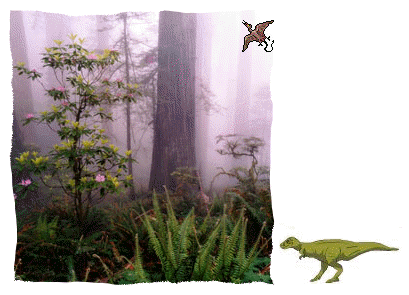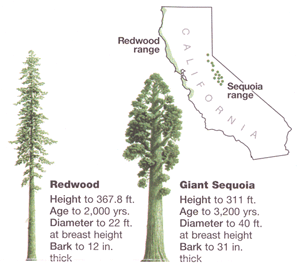| |
|
|
We
will never know when Sequoia sempervirens or coast redwood
first sprang to life upon earth. The date was well before
the human species came on the scene. There is evidence that
coast redwoods have existed as far back as 65 million years
ago. This was the end of the Cretaceous period, the last time
that dinosaurs, like Tyrannosaurus rex, Triceratops, and Velociraptor
roamed the earth.
 Even
today, conifers, the plant division that includes coast redwoods
along with other trees like pine, cedar, fir, and cypress,
are the oldest, the largest, and the tallest of
all living organisms. Methuselah, a 26-ft bristlecone pine
in the White Mountains of eastern California, is estimated,
as of 2006, to be 4772 years old. In 1964, a live bristlecone
pine in eastern Nevada named Prometheus was cut down and later
found, tragically, to be 4862 years old. Giant sequoia (Sequoia
giganteum) are the largest trees in the world, measured by
the amount of wood they contain. General Sherman, a tree in
Sequoia National Park (California), is 274.9 feet high, 102.6
ft around at its base, and weighs an estimated 2.7 million
pounds. The distance from the ground to its first large branch
is 130 ft—enough to accommodate the Lincoln Memorial
and then some. According to the National Park Service, the
giant sequoia, or Sierra redwood, only grow in about 75 isolated
groves in the Sierra Nevada, the eastern mountains of California. Even
today, conifers, the plant division that includes coast redwoods
along with other trees like pine, cedar, fir, and cypress,
are the oldest, the largest, and the tallest of
all living organisms. Methuselah, a 26-ft bristlecone pine
in the White Mountains of eastern California, is estimated,
as of 2006, to be 4772 years old. In 1964, a live bristlecone
pine in eastern Nevada named Prometheus was cut down and later
found, tragically, to be 4862 years old. Giant sequoia (Sequoia
giganteum) are the largest trees in the world, measured by
the amount of wood they contain. General Sherman, a tree in
Sequoia National Park (California), is 274.9 feet high, 102.6
ft around at its base, and weighs an estimated 2.7 million
pounds. The distance from the ground to its first large branch
is 130 ft—enough to accommodate the Lincoln Memorial
and then some. According to the National Park Service, the
giant sequoia, or Sierra redwood, only grow in about 75 isolated
groves in the Sierra Nevada, the eastern mountains of California.
Coast redwoods, currently
the tallest trees in the world, have reached close to 400
ft and some have survived over 2000 years as well. In 2002,
the Stratosphere Giant, a coast redwood in the Rockefeller
Forest of Humboldt Redwoods State Park in northern California,
was measured at 369 ft 4.8 in. The Dyerville Giant, a coast
redwood in the same park, was estimated to be 1600 years old
when it toppled in March 1991. At 372 ft it was the tallest
tree in modern times. According to the Guinness Book of Records,
the tallest tree ever measured was a Eucalyptus regnans or
gum tree from Victoria, Australia. A forester, William Ferguson,
reported in 1872 that it was 435 ft. tall. Some have questioned
the reliability of logging records almost 150 years old. In
any event, such giant specimens do not exist today. The largest
living specimen of the swamp gum is about 302 ft high.
LIke the dinosaurs, the old
coast redwoods themselves seem almost from another time, awesomely
large, not on the same scale as a human-sized world. They
have been called "living fossils." In Calistoga,
California, you can see true coast redwood fossils. They are
part of a petrified pliocene forest, discovered in the 1850s,
with specimens of coast redwood trees that were toppled about
3 million years ago by a volcanic eruption. One of the specimens
is 150 ft long.
 Ancient
relatives of the coast redwood extended into central and western
North America, Greenland, Spitzbergen, Europe, and Japan.
At present, coast redwoods grow only along a narrow band from
southwestern Oregon to Monterey, California. They thrive along
the coast in northern California where
cool fog from the ocean brings moisture for growth and blocks
the evaporating rays of the sun. Condensed fog slowly drips
off the redwood foliage watering the roots of the giant trees
as well as the ferns and plants surrounding them. Ancient
relatives of the coast redwood extended into central and western
North America, Greenland, Spitzbergen, Europe, and Japan.
At present, coast redwoods grow only along a narrow band from
southwestern Oregon to Monterey, California. They thrive along
the coast in northern California where
cool fog from the ocean brings moisture for growth and blocks
the evaporating rays of the sun. Condensed fog slowly drips
off the redwood foliage watering the roots of the giant trees
as well as the ferns and plants surrounding them.
Coast redwoods are among the
most complex plant forms on earth. A single tree may have
many re-sprouted trunks so that the crown of a redwood is
almost like a self-contained forest. In fact, "baby"
redwoods generally sprout around the base of a tree, taking
in nutrients from the mature tree and forming a circle of
trees called a fairy ring.
Today only about 5% of the
coast redwoods, here before the European settlers, remain.
The history of MRC forests is in small part a story of ancient
survival as a few pockets of old growth remain across our
landscape and provide unique and indispensable habitat for
certain wildlife. In the main, however, it is a story about
how the land has been impacted by social, industrial, and
technological change and how new attitudes and visions are
shaping its future.
|
|
|
|
Illustration Credit
The illustration comparing
the distribution and characteristics of the coastal redwood
and the giant sequoia are courtesy of the National Park
Service.
Secondary Sources
Mattison, Elise."California's
Fossil Forest," California Geology 44 (1990):195-202.
Noss, Reed, ed. The
Redwood Forest: History, Ecology, and Conservation
of the Coast Redwoods. Washington, DC: Island Press, 2000.
Snyder, James A. "The
Ecology of Sequoia sempervirens." Master's Thesis, San
Jose State University, 1992.
|
|
|
|